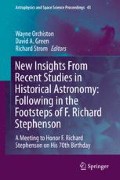Abstract
The solar eclipse of AD 364 June 16 described by Theon of Alexandria in his commentary on Ptolemy’s Almagest has been used to study the secular acceleration of the Moon and the long-term changes in the rate of rotation of the Earth since the first investigations of these topics. All previous studies of this eclipse have been based (directly or indirectly) upon the 1538 Basel edition of the Greek text of Theon. In this paper I discuss the implication for studies of the Earth’s rotation of a correction proposed by A. Rome in 1950 to the text of the passage describing this eclipse in the Basel edition.
Access this chapter
Tax calculation will be finalised at checkout
Purchases are for personal use only
References
Fotheringham, J. K. (1920). A solution of ancient eclipses of the Sun. Monthly Notices of the Royal Astronomical Society, 81, 104–126.
Jones, A. (2012). Theon of Alexandria’s observation of the solar eclipse of A.D. 364 June 16. Journal for the History of Astronomy, 43, 117–118.
Morrison, L. V., & Stephenson, F. R. (2004). Historical values of the Earth’s clock error ΔT and the calculation of eclipses. Journal for the History of Astronomy, 35, 327–336.
Newton, R. R. (1970). Ancient astronomical observations and the accelerations of the Earth and Moon. Baltimore: The Johns Hopkins University Press.
Newton, R. R. (1979). The Moon’s acceleration and its physical origins (As deduced from solar eclipses, Vol. 1). Baltimore: The Johns Hopkins University Press.
Rome, A. (1950). The calculation of an eclipse of the Sun according to Theon of Alexandria. Proceedings of the international congress of mathematicians. Providence, pp. 209–219.
Steele, J. M. (2000). Observations and predictions of eclipse times by early astronomers. Dordrecht: Kluwer.
Steele, J. M. (2012). Ancient astronomical observations and the study of the Moon’s motion (1691–1757). New York: Springer.
Stephenson, F. R. (1997). Historical observations and Earth’s rotation. Cambridge, MA: Cambridge University Press.
Stephenson, F. R., & Morrison, L. V. (1995). Long term fluctuations in the Earth’s rotation: 700 BC to AD 1990. Philosophical Transactions of the Royal Society of London A, 351, 165–202.
Author information
Authors and Affiliations
Corresponding author
Editor information
Editors and Affiliations
Rights and permissions
Copyright information
© 2015 Springer International Publishing Switzerland
About this paper
Cite this paper
Steele, J.M. (2015). The Eclipse of Theon and Earth’s Rotation. In: Orchiston, W., Green, D., Strom, R. (eds) New Insights From Recent Studies in Historical Astronomy: Following in the Footsteps of F. Richard Stephenson. Astrophysics and Space Science Proceedings, vol 43. Springer, Cham. https://doi.org/10.1007/978-3-319-07614-0_4
Download citation
DOI: https://doi.org/10.1007/978-3-319-07614-0_4
Published:
Publisher Name: Springer, Cham
Print ISBN: 978-3-319-07613-3
Online ISBN: 978-3-319-07614-0
eBook Packages: Physics and AstronomyPhysics and Astronomy (R0)

